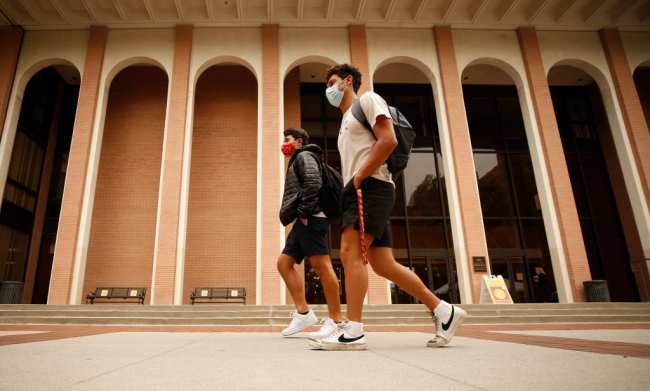You have /5 articles left.
Sign up for a free account or log in.

Experts say colleges should consider re-implementing COVID-19 prevention measures like masking and social distancing.
Al Seib/Contributor/Getty Images
When the new Omicron variant of COVID-19 appeared in South Africa, students at the Tshwane University of Technology were some of the first people to test positive for the variant, which the World Health Organization has labeled “of concern.” In response, officials at the public university in Pretoria delayed exams, the Associated Press reported. Days later, a student at the University of Nottingham was identified as one of the first Omicron cases in the United Kingdom.
U.S. college and university officials are now wondering when Omicron will appear on their campuses. As of Tuesday evening, no Omicron cases had been identified in the U.S., but Gerri Taylor, co-chair of the American College Health Association COVID-19 task force, said it’s not a question of if but when the variant will be detected Stateside.
“It just makes sense that there will be a case,” Taylor said. “The world is so international and people are traveling all the time, so it would be really unlikely for the U.S. to be spared this.”
When it does arrive, colleges must be ready. Taylor and her co-chair, Anita Barkin, say that vaccines will be essential to slowing the spread of the new variant. In South Africa, vaccination rates among college students are low—only 22 percent of people ages 18 to 34 have been vaccinated against COVID-19. Vaccination rates among college-age adults in the U.S. are much higher, at 68 percent, but they still trail the national average.
The Omicron cases at TUT and Nottingham echo some of the first-ever cases of COVID-19 in the United States: Lake Washington Institute of Technology became an early U.S. COVID-19 epicenter in February 2020, when a handful of nursing students and faculty members contracted the virus at a local nursing home. Experts say college campuses can be particularly vulnerable to viral outbreaks, but proactive safety measures and frequent communication could keep campuses from becoming an Omicron hot spot.
Campuses are busy. College students live, work and study together—oftentimes in large groups and close quarters—and they also move on and off campus for part-time jobs, internships or social events. This makes it easy for viruses to pass through the population quickly, Barkin said.
“In a pandemic, the closer you are to people, unfortunately, the riskier it can be in terms of transmission of infection,” Barkin said.
COVID-19 is not the first time that institutions have had to grapple with infectious disease on campus—H1N1 and annual norovirus and influenza outbreaks have tested campuses before—but the two years of COVID-19 pandemic are unprecedented, Taylor said.
Prior to news about Omicron, colleges and universities had been backing off some of their strictest masking and distancing protocols. Barkin and Taylor suggested college officials consider re-implementing prevention measures, as difficult as that could be.
“Colleges have done an even better job than many organizations in controlling cases on their campuses because they put into place all of these great strategies,” Taylor said. “They have mask requirements, vaccine requirements, physical distancing—they’ve done work on their air filtration.”
The same prevention measures will likely work to curb the spread of Omicron.
For the institutions that have the capacity to do so, Taylor encouraged genome sequencing—the chemical lab procedure that allows researchers to identify the Omicron variant apart from other strains of COVID-19. The screening procedure is used to determine whether Omicron is present within a population.
Health officials still don’t have enough evidence to say whether Omicron will be more transmissible than past iterations of the COVID-19 virus, or whether existing COVID-19 vaccines will be fully effective against it. Researchers say it will take at least two weeks for them to acquire concrete information about the new variant.
While college leaders wait for more information about the threat Omicron may pose, Barkin encourages them to be transparent and communicative with students and employees.
“It’s hard to act right now, because you don’t have a lot of information,” Barkin said. “Leaders on campuses need to communicate that they are aware of this variant, that they are monitoring the situation carefully and that they will make decisions based on the best scientific information and the data available.”
While a new variant isn’t what anyone hoped for, college officials, students and employees must remain vigilant as Omicron continues to spread.
“You just can’t totally let down your guard at this time,” Taylor said. “It would be really nice to go back to normal—we all wanted that. We all thought that was going to happen. And here we are.”








